
Glowy things!
Review date: 14 March 2003.Last modified 03-Dec-2011.
There seems to be general agreement that you don't have a hot rod PC if some portion of it isn't lit up in a militantly non-useful way.
I'm not entirely unfamiliar, myself, with this area of endeavour.
A lot of PC light-up gear has crossed over from the boom car scene; a device that's meant to light up someone's amplifier, see-through subwoofer box, turbo boost gauge, windscreen washer nozzles or dumb accessory is likely to work fine for lighting up a PC, because both cars and PCs have a handy-dandy 12 volt supply rail (for the time being, anyway).
Automotive power is actually 13.8 volts when the engine's running, which means that a lot of this gear is a bit dimmer when you use it in a PC - but it's dimmer in a car with the engine off, too, and the extra voltage headroom means it's likely to last longer.
Anyway, there are three basic lighting technologies used for decorating both cars and PCs, and none of them is the plain old incandescent tungsten filament that still operates in most of the world's electric lights.
Herewith, some gadgets using each of these technologies.
Cold cathodes
The most popular, and the brightest, of the decorative light technologies is the cold cathode fluorescent lamp (CCFL). CCFLs are available in a variety of cheerful colours, including near-ultraviolet. There are also white ones, which are used to light LCD panels.
CCFLs are bright, and they're quite cheap. The most commonly seen size is the 300mm (12 inch) type, but you can also get little 100 and 150mm units that're easier to fit into a PC.
CCFLs for decorative use always have a clear plastic protective tube around the thin and fragile glass tube that actually emits the light, and they also always have two supply wires that go in one end of the lamp assembly. One wire connects to the end of the tube right next to the wire entry point; the other one goes to the other end of the tube. Recent CCFL models have a super-thin wire going to the far end, which you can only see if you look very closely; older CCFLs have a thick and noticeable far-end wire, which casts a shadow in their output.
There are also some rather fancy phosphor coatings around these days, as we'll see. CCFLs tubes don't have to be just one colour.
CCFLs and the inverter/ballasts that they run from are now becoming mix-and-match items. Either all of these things are being made in the one factory, or multiple manufacturers have reached agreement on the plugs and sockets they're going to use. Which is nice.
This isn't to say that CCFLs don't often come with a piece of paper sternly warning you never to use one reseller's inverter with another reseller's tubes. It is, indeed, possible that a given inverter might not work right with a different tube. If you plug 100mm tubes into an inverter that expects 300mm ones, something bad may happen. But if you stick with the right length of tube, everything seems likely to work fine together.
Here, for your delectation, is a representative sample of what 300mm CCFLs and their supporting hardware tend to look like today. This gear is from Bitsmodding, the stuff-that-does-nothing-useful-but-looks-cool division of CPU cooler company Bitspower, various of whose heat sink products I've checked out in my monster cooler comparison.
The above picture shows all of the CCFL gear Bitspower sent me. One inverter, four tubes. The two black tubes are that colour because they're ultraviolet (UV) lamps; they're made from Wood's glass, which is dyed to block most visible light. More on them in a moment.
The mix-and-match inverters that current CCFLs come with all have one twelve volt input connector, and two high voltage outputs. You can use them with one or two CCFLs, and the two tubes don't have to be the same colour. In dual-tube mode, the inverter won't run the tubes quite as brightly as it would if you connected only one tube, but the difference is very slight.
The other hardware that comes with the Bitspower kit is also completely standard. It's quite hard to find a CCFL kit these days that doesn't come with these same extras.
You get some bits of self-adhesive hook and loop material for mounting the inverter and the tubes. You get a power cable with a pass-through four-pin "Molex" disk drive power connector on one end, a two-pin plug for the inverter on the other, and a two pin socket interrupting one of its conductors in the middle. You get a round on/off rocker switch on its own bit of wire, which plugs into the power cable's middle socket. You also get an extension cable for the rocker switch, which should let you install it anywhere you like in your case. And, finally, you get a decorative round sticker that you can use to cover up any slight imperfections in the hole you cut in your case to mount the switch (assuming you bothered to do so; you could just dangle the switch out the back of the box, or leave it tucked inside).
Plug it all together and fire it up, and you get something like this.
Bitspower sent me one plain old Cerenkov-blue CCFL, and one of the new-fangled multi-phosphor models. This one's red and green, and no dimmer on either half than a similar length of a one-colour tube would be.
Cold cathode lamps don't actually run cold. Like all fluoros, they warm up in use, and are brighter when warm than when cold.
After a few minutes of warm-up time, the Bitspower CCFLs settled to about 540 milliamps (mA) of draw at 12 volts. This doesn't mean the two tubes between them are emitting 6.48 watts (12 times 0.54; watts equals volts times amps) of light, though; it just means the rig is consuming that much power. The fact that the lamps get noticeably warm, despite consuming only about two thirds as much power as the humblest of compact fluorescent bulbs and spreading that power out over a thin straight tube, indicates that there's considerable power being wasted.
The efficiency of CCFLs is lower than that of conventional hot cathode tubes. You can only expect to get 20 to 30 lumens per watt (LPW) out of small CCFLs like these, which is in the same range as unremarkable LEDs. Some LEDs can manage better than twice this efficiency.
Regular home and office hot cathode tubes are better still; they routinely manage 60 to 80 LPW. Compact fluorescent bulbs are generally up around 60 to 70, too. Hot cathode tubes as short as these CCFLs aren't very efficient either, mind you, but even a CCFL big enough for a normal household flouro batten would lose to a cheaper hot cathode lamp. Cold cathode lamps' chief advantage is that they turn on instantly, because there's no filament warm-up time.
Note that the lumen isn't a perfect unit for comparing light power, because it doesn't take into account the fact that the human eye sees X watts of green light as being brighter than the same wattage of light elsewhere in the visible spectrum. The further away from green you get, the worse the eye's response becomes. But even a 30 lumen per watt green CCFL won't look as bright as a 65 lumen per watt compact fluoro at the same power.
The take-home message of all this rambling is that while these lights are darn bright by thing-inside-your-computer-case standards, they're not bright enough to light up a room to more than mood-lighting levels.
What about the black lights, I hear you ask?
Well, Bitspower threw in these items along with the CCFLs. These translucent 80mm fans have two unusual features. One, a thermal probe on the end of about 15cm (six inches) of wire, which controls their speed through the not-terribly-remarkable range of 2000 to 2500 RPM, and which therefore might as well not be there, if you ask me. They adjust from "low" to "slightly less low" power; big deal
Unusual Feature Two is these fans' ability to glow, passively. They've got no lights built in, but their plastic fluoresces under ultraviolet light.
It fluoresces brightly, too, at least when the fans are sitting right on top of the two UV CCFLs (which are drawing a healthy 580mA, after warm-up). It is not overstating the case, I think, to say that these fans look seriously trippy.
The fan-and-UV-CCFL combo is not nearly as bright as a couple of plain CCFLs, though, and the fans won't look as impressive if they're not directly backed by blacklights. But if you manage to set them up so that the UV lights aren't more than an inch or two away from them, and if there's nothing in between to cast a shadow, then these fans will be very quite visibly weird in a normally lit room.
The fans come with mounting screws, a finger guard and a four-to-three-pin power adapter so you can plug them in even if you don't have a spare motherboard fan header; the CCFL UV lamps are respectably bright for their size. Worth buying, in both cases, if you ask me.
You can read more about near-UV lamps in my old review here.
SunBeam Technology sell a lot of different CCFL gear, but they don't sell this exact kit any more. Their CCFL kits now look like everyone else's - little plastic-box inverter, clear tubes. I'm reviewing this old one because, ahem, it kind of fell down the back of my to-review pile and got forgotten about. Sorry, SunBeam.
Anyway, this kit or another very like it may well still be on sale here and there, and it's a bit odd. Its tubes have colour-striped sleeves, for some reason - the stripes only obstruct the light getting out, so I'm not sure why they're there. And, odder still, its inverter has no case - just a hook and loop wrap, which you have to unwrap to plug in power and tubes.
Apart from these features, the SunBeam kit is the same as everyone else's. Same wiring, same operation.
The case-less SunBeam ballast made it easy for me to show you what's always inside these things. They're very simple little transformer-based high voltage inverters, and they don't produce a high enough voltage that they need to be "potted" in epoxy or other goop to prevent arcing. The current plastic-box inverters have connectors that point out of the ends rather than up from the board, but they're otherwise very much the same as this bare board.
The high frequency and voltage that CCFLs run from, by the way (some tens of kilohertz and several hundred volts), means that they're very sensitive to cable capacitance. The more capacitance their cable has, the more power it'll suck away and the dimmer the light will be. If you bunch both fists around the floppy white wires running to a CCFL, you'll practically extinguish it; it'll probably only light at the cathode end where the wires enter the lamp assembly.
Initially, I thought this SunBeam kit wasn't very good, because on switch-on its lamps were a lot dimmer than the ones in the other CCFL kits I looked at.
Here, for instance, is the blue Sunbeam tube, at the top, compared with the Bitspower blue. The stripes block a bit of light, but they don't come close to accounting for the difference.
Even with both tubes plugged in, the SunBeam kit starts out drawing only about 170mA at 12 volts, versus 270mA or more for newer kits. The SunBeam tubes did this with other inverters, and the SunBeam inverter did this with other tubes, so I thought all of the SunBeam components were weak.
As it turned out, though, the SunBeam kit just started dimmer, and took longer to warm up, than the newer kits. After a few minutes of run time, it made it up to the same brightness as the other kits, and a 550mA current draw.
SunBeam's current CCFL kits look, and probably act, exactly the same as everyone else's.
Like, for instance, this one, from PC Range, here in Australia.
This single-tube kit looks entirely unremarkable; little inverter box, the usual wiring and hook and loop stuff, and a decent instruction sheet. The CCFL's of the older big-return-wire type, too.
I think you can forgive the return wire and its shadow, though. 100mm each of red, green and blue, at your service.
At the moment, the only cold cathode kits PC Range has available have a single blue tube, but the inverter has the usual twin output connectors, and PC Range sell extra blue tubes for $AU19, UV ones for $AU20 and tri-colour ones for $AU21.
Australians, by the way, can also buy CCFLs from my sponsors Aus PC Market, who sell pretty much the same mix-and-match kits as everyone else these days. They've got them in their Case Mods section, and there are single and double 150mm and 300mm kits in all colours, including UV and multi-coloured.
Bubble Lights
A single standard 5mm LED is quite enough to make a medium brightness accent light, but not if it's just sitting there with its normal domed lens over the top of it. Then, it'll project a simple pool of light, which is fine if you want to light up some particular other object, but no good if you want the light itself to be the focus of interest.
Flexiglow had an idea, though. They stuck LEDs in the ends of clear acrylic tubes with bubbles moulded into them...
...and the result was the Bubble Light.
Bubble Lights aren't much to look at when they're turned off; a little black box that looks like a CCFL inverter (but isn't), two light tubes with self-adhesive hook-and-loop fasteners on the ends, and a slide switch that lets you pick off, always-on or flashing mode. In flashing mode, first one tube flashes, then the other.
The tubes are crystal clear, and the bubbles inside them are easy to see. There's also a reflective cap at the end opposite the LED, which enhances the tube brightness a bit by stopping light from escaping.
Turn on the Bubble Lights and things get more interesting. The bubbles...
...do their job well.
OK, it'd be cooler if the bubbles circulated, or something. But it's not as if these things are expensive; here in Australia, Aus PC Market has them for $AU36.30 delivered (Aussies who'd like to buy the blue, green, purple, red and yellow models can click here, here, here, here and here, respectively). As I write this, $AU36.30 is around the $US22 mark.
Since the Bubble Lights run from low voltage DC, there's no inverter hardware inside their little controller box. If it weren't for the flash function, they'd hardly need anything in there at all.
The cables to the two Bubble Lights in each kit, and the power connection for the controller box, all have in-line plugs of the same sort as are used by most current CCFL kits. You can therefore use Bubble Lights with sound-triggered controllers, or dimmers, that take 12VDC input and deliver a maximum of 12VDC output. Australians can buy just such a controller from Aus PC Market here, by the way).
What you want to connect to such a gadget, though, is the Bubble Light controller - not a bare Bubble Light tube. The tube, without the in-line resistance of the controller box, will blow its LED instantly from 12 volts.
Four single Bubble Light rods next to each other. Each one is part of a pair; the other light in each pair just isn't in the frame.
These four are red, yellow, green and purple; I think purple's my favourite. The red one at the front is a bit shorter than the others, because it's part of a non-standard prototype red/blue pair that I was sent before I got the retail lights. It's representative of what the retail red ones look like, except for its length.
If you want to light up the room, the Bubble Lights are not for you. Each one's only got one LED in it, and they're clearly not even being driven terribly hard. From 12 volts, in constant-on mode, the green, purple and orange Bubble Lights drew 46, 48 and 57 milliamps respectively. The blue/red prototype unit drew 53mA. Coloured LEDs are a quite efficient source of light in lumens-per-watt terms, but when you take into account the fact that a lot of the input power is being thrown away by the current limiting hardware in the controller box, these things really can't be very bright. They're being driven pretty much at the LEDs' normal spec current, which means these things ought to last pretty much forever. The typically quoted 100,000 hour lifespan for LEDs (which is how long it'll take them to get down to 80% of their initial output, not how long until they die completely...) doesn't apply for overdriven diodes, but these ones aren't.
And they are bright enough that in any normally lit room, they shouldn't look washed out. Direct sunlight will wash them out completely, but ordinary indoor lighting, day or night, won't be too bright for them. Just don't expect to be able to light other stuff up with them.
EL fun
Electroluminescent (EL) material is, essentially, an unrolled light emitting capacitor, driven from a medium-high voltage (120-odd volts) at a medium-high frequency (a few hundred to a few thousand Hertz). It takes advantage of the fact that some materials emit light when backed with a dielectric and sandwiched between two conductors.
Practically any object can be covered with EL material; it's not a small light source like an LED, or a hard-to-shape one like a glass tube. You can't quite paint it on, but EL strip is quite flexible.
On the down side, as anybody who's used their electroluminescent wristwatch backlight to light the way down the side path will know, EL isn't terribly bright. If your eyes are adjusted to darkness already then a square inch or two of blue-green EL material is adequate to at least give you an idea of where you're putting your feet, but you'd have to cover your whole ceiling with the stuff if you wanted to read a book.
EL is also not suitable for long term use. EL materials only have life spans in the few-thousand-hour range. After a year of accumulated on-time, your EL strip is probably going to be a lot dimmer than it was when new.
EL is still good for accent lighting, though, and stick-on strips of the stuff are popular among case modders, those interested in making a snappy suit in which to play Space Paranoids, and so on.
Here's your standard basic self-adhesive electroluminescent tape kit. Here in Australia, PC Range sell it for $AU24 plus shipping.
This 60 centimetre strip's a bit shorter than the Tweakmonster strip I review here, and it has a couple of other differences too.
This one lights up green, not blue, for a start (although, as I write this, PC Range only have blue strips in stock). And this one's inverter probably isn't any more electrically simple than the inverters used by other simple on-or-off EL gear, but it looks simpler. It's an Epicenter E12-672N-1 module, about 2.5 by 2 by 1 centimetres, with a smooth epoxy-potted base. It's fed by a non-passthrough four pin socket, so you'll need one spare PSU connector.
The EL tape only draws 36.5 milliamps at 12 volts, which is rather lower than the draw of the slightly longer Tweakmonster strip. Judging by their relative brightness, though, I think that's just because the Tweakmonster strip has a less efficient power supply, or is losing power to stray capacitance, or something. Anyway, together with EL material's natively lousy lumens per watt rating (6 to 10 LPW...), the low power draw means this thing isn't too bright.
Since it's green, though, it's more visible than you might think for a 440-odd-milliwatt device with less than half the efficiency of a normal light bulb. As an accent light, it'll do fine. You can also mould EL tape to fit quite extreme corners; a bit of heat from a hair dryer helps it match sharp edges.
And then, there's this.
This is a round floppy drive cable with EL wire wound around it. This one's only got two connectors - one for the motherboard and one for a 3.5 inch A drive - but that's all practically anyone needs these days, if they need a floppy drive at all. The versions of this cable that Aus PC Market here in Australia are stocking as I write this have the usual three connectors, and are 48 centimetres long; they're $AU41.80 delivered.
The cable has a little inverter box with a passthrough four-pin power connector, and you get some double-sided tape for mounting the inverter. That's it for the hardware.
There's an IDE-lead version of the same thing; it's 75cm long, which is well over the official parallel ATA maximum cable length, which I rabbit on about here). The length means you probably don't want to be using it at speeds above Ultra DMA/33, no matter how fast the package says it's good for. It's $AU52.80 delivered.
On the face of it, it doesn't sound entirely sensible to wind something energised above 100 volts at a pretty high AC frequency around a floppy or, worse yet, hard drive data cable. Capacitance, induction, data corruption, lost bits, suffering.
Fortunately, this isn't actually a problem. These round cables, like every rounded cable worth using, have a braided shield over the conductors almost from end to end. The shield's earthed, and so noise from the EL wire can't have a significant influence on the conductors, except at the very end. The end doesn't seem to bring enough conductors close enough to the cable to make a difference. Hence, against all expectations, the things actually work.
They look pretty nifty, too.
You can get IDE and floppy leads a heck of a lot cheaper than this, of course. But they don't have a glowing blue spiral around them.
Aussies who'd like to buy one of these leads can find the three-connector floppy version here, and the IDE version here.
Slight practicality
And now, the one gadget in this comparison that actually does something useful, and the first LED-lit one.
This USB Flex Light is another product from Aussie outfit PC Range. They sell it for a mere $AU12. Plus another eight bucks for shipping, but whaddayawant.
There are quite a few of these sorts of lights on the market today. They started with brand name versions, some fancier than others, but now there are plenty of cheaper options.
This version's the generic Taiwanese edition; I think the exact same thing's sold by various dealers as a "USB Snake Light". Anyway, the idea's simple enough. It's a miniaturised version of the gooseneck lights that screw into spare mike connectors on mixing desks - not a high brightness watchmaker's friend, but something that just gives you enough light to be able to see your controls (in this case, probably laptop keys) without making your location overly obvious to audience members, other long-haul plane passengers, or snipers. For anything much further away than a laptop keyboard, we're talking night-light brightness.
Plug one of these things into a USB port and they use USB's five volts to run a lamp, which you can use to light up your laptop keyboard. Or your desktop PC keyboard, for that matter, if you're using it somewhere dim like a LAN party. USB can deliver quite enough juice to run a little light, or fan, among other things.
The cheapest and nastiest of these USB lights use incandescent torch globes. The good ones, like this one, use LEDs.
The Flex Light's lamp is a plain old 5mm white LED, hiding behind a plastic lens. The lamp assembly's crimped onto the end of the gooseneck and so not at all easy to remove, but only the nosey like me should ever have any need to. All that's going to be in there is the ultra long life, shockproof LED and, maybe, its series resistor, which is what brings the voltage across the LED down from USB's 5V to the 3.6-odd volts it's likely to want.
In use, the Flex Light's not amazingly bright (that's a ten second, F11, ISO 200 image you're looking at there, which is why the lamp end has a cutting-torch lens flare on it), but it does the job. All it's meant to be is a keyboard light, and it does that job well enough.
The 370mm (14.5 inch) gooseneck lets you set the Flex Light up to work properly whether your laptop has side or rear USB ports, and it does pretty much stay where it's put, though it's prone to flopping a bit if you move the computer around.
Apparently, the correct term for the behaviour of goosenecks like this is "semi-obedient", and I think that's a rather good description. It's not hard to find a setup that doesn't flop right over with slight provocation; a bit of movement's not that annoying.
I didn't bother doing power consumption measurements on the Flex Light. Forgive me. The reason why I didn't bother is that there's really no need; there's no way this thing can have a significant impact on laptop battery life, and its effect on desktop PC power consumption or PSU load will be extremely close to zero.
A laptop with, say, a 10.8V 3.2Ah battery (that's the battery spec for my vintage ThinkPad) will have, assuming its battery lives up to its specs, about 34.5 watt-hours of energy from a full charge. Drive a white LED (and inline resistor) all the way to 50mA from 5V (25mA is more like it for most LED lighting products; flashlights often drive their LEDs a lot harder, but this LED's dim enough that it's clearly not overdriven), and 34.5 watt-hours will last you 138 hours.
Since your laptop's battery life will very probably be less than four hours, you'll still get better than 97% of that run time with the Flex Light plugged in and glowing whenever you use the laptop. Quite possibly, more than 99%. Three AA alkalines would run the Flex Light for at least two straight days.
And now, back to the foolishness.
Fancy fans
LED-lit fans are easy drop-in pretty-mods, for any place where a fan's visible from the outside of the case. The fan frame and impeller are made from clear plastic, and with LEDs are embedded in the frame, and powered by a wrap-around flexible circuit-tape. These things are also usually pretty low powered; they're not for wind tunnel computing, but they're perfectly adequate for most case fan jobs.
I've checked out LED fans before, but they keep on coming, with some variations.
Aus PC Market sells these 80mm "Flolite" fans, which are pretty representative of the current LED-lit state of the art. They all look like this with the power off - translucent frosted-finish plastic, shiny holographic hub sticker. They come with standard mounting screws and a power plug adapter. You don't get a finger guard with them, though.
Power 'em up, and there is light. Not an incredible amount of light; the LEDs face the blades and so a lot of their light is lost to the viewer on either side of the fan. But enough reflects and refracts that the glow's obvious with normal indoor lighting.
These fans all have the same motor assembly, but their different LEDs give them different power draws. The RGB one draws 140mA, the green one 164mA, and the red one 172mA. As you'd expect from these less-than-two-watt ratings, they're pleasingly quiet, and their bearings ought to last well, too. They'll work fine as front, side or top intake fans, or as a replacement in a PSU.
As you'd expect, the single-colour fans cost a bit less than the funkier red-green-blue model. Single colour is $AU18.70 delivered; tri-colour is $AU23.10 delivered. Aussies who'd like to buy the single colour models can find them here (you'll have to specify which colours you want in the comments field when you check out, since there's only one catalogue item for all three colours). The tri-colour version is here.
These "Crystal" fans, sold cheap by Xoxide, are a bit different from the LED-lit run of the mill.
For a start, the "Crystal" name is warranted; the blades of these fans have a smooth finish, and are pretty much crystal clear. This means they reflect even less light from surrounding LEDs than frosted blades do, but I think the more specular reflections look groovy.
The Crystal fans come in 80mm and 92mm variants (these ones are 80s; if you want a lit fan much larger than 92mm, you'll have to do it yourself), and have the usual power and mounting accessories, and finger guards.
They also have two distinct types of lighting...
...both of which you can see here.
The brightly lit fan has the usual surrounding LEDs - four of them, versus the three that many cheap LED fans have. The drab looking fan looks that way because it has only two LEDs. They're mounted in the hub of the fan, and flash at slightly different rates, and aren't pointing at the camera - if they were, it'd look a lot brighter than its four-LED colleague.
Personally, I'm not really looking for a fan that projects a couple of unevenly flashing blue circles on the wall opposite the computer, but if you are, then this could be the fan for you.
Both of these fans have the same low power, low noise motor, but the four-LED model draws 170mA, thanks to its extra photon-squirters. The flashing-hub model draws about 105mA, on average.
Once you've got your stylin' light-up fan, you can attach it, or any of a variety of other silly or non-silly air-shifters, to a conventional 60mm-fan heat sink. With...
...this. It's a fan reducer for 80 and 92mm fans, but it's so much more.
Well, it's a bit more.
It comes with a full set of garish gold mounting screws, and with a rubber gasket that should make all but the best-balanced fans noticeably quieter. It's got a pass-through power connector arrangement with a slide switch that lets you run your fan from the full 12 volts, or from about 11.3, or from about 10.6, for full, 90% or 80% power. And...
...it's got LEDs.
I can't honestly say that these LEDs have been positioned brilliantly by an optical genius who used painstaking ray tracing to attain optimally aesthetic light dispersion, but they do look pretty cool. You can turn off any or all of the LEDs with the three (undocumented) DIP switches on the adapter.
Fan adapters like this are never terribly efficient, as far as air flow goes. Computer fans don't like pushing against much resistance, and adapters always present a pretty resistive flow path. An X watt 80mm fan will, all things being equal, have a higher free air flow rating than a 60mm fan with the same power rating, and will also make less noise. Into an adapter, though, the 80mm unit may well move less air than the 60mm would. But a more powerful 80mm fan will still make less noise and last longer than the 60mm alternative. Adapters aren't a completely dud idea. And this one sure looks neat.
OK, it's been done before, but this is a nice implementation, and shouldn't be terribly expensive, either.
This product hasn't quite made it onto Aus PC Market's Web site yet; when it does, I'll update this page with a link and a price.
More on brightness
The highly comprehensible babble about lumens per watt higher up in this review may not have given you a clear idea of the relative brightness of LEDs, CCFLs and EL objects. This might help.
In this one second, f27, ISO 100 exposure, the Bubble Light and Light Strip both, at least, look as if they're doing something, though they're also reflecting a lot of light from the CCFL. The fluorescent tube, however, is so overexposed that it looks like a pimp lightsaber.
This exposure's only a tenth of a second, the same as the other glowing-CCFL pictures in this review. Now the CCFL's correctly exposed (the tube isn't a white line), but the Bubble Lights don't look like much, and the Light Strip is pretty much just a reflector.
There's a big difference in brightness between LED and EL devices and CCFL ones. If you want to light up stuff to make it pretty in normal night-time indoor light levels, they're all fine. If you want to light up an area so you can see it - the normal function of lighting devices - individual LED spotlights (or "super-LEDs") are good enough for small areas, but fluorescent lights of all kinds remain in a class of their own.
Overall
With the exception of the Flex Light, there's not a thing on this page that isn't either completely unnecessary for the creation of a functional and speedy PC, or replaceable by something less decorative and cheaper.
That, of course, is not the point. This stuff is fun. Maybe not tasteful, but definitely fun.
Pretty much anything that makes a computer light up gets my recommendation. We've all seen enough plain beige boxes to last a lifetime.
Bitsmodding CCFLs and fans kindly provided by Bitsmodding.
SunBeam CCFLs kindly provided by SunBeam Technology.
RGB CCFL, electroluminescent strip and Flex Light kindly provided by PC Range.
Bubble Lights kindly provided by Flexiglow.
(Aussies who'd like to buy the blue, green, purple, red and yellow models from Aus PC Market can click
here,
here,
here,
here and
here, respectively.)
Electroluminescent-lit drive cable kindly provided by Aus PC Market. Australian shoppers can go here for the floppy version and here for the IDE one.
Flolite fans also kindly provided by Aus PC Market. Australian shoppers can find the single colour models here and the tri-colour version here.
Crystal fans kindly provided by Xoxide.
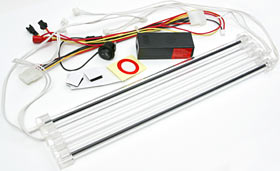
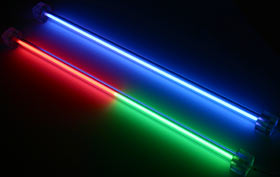
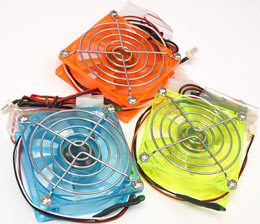
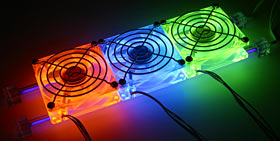
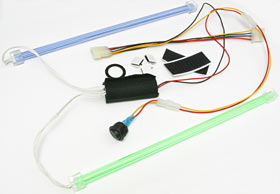
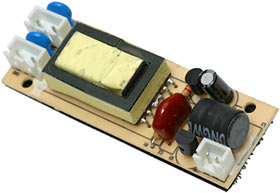
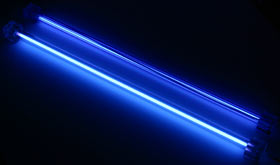
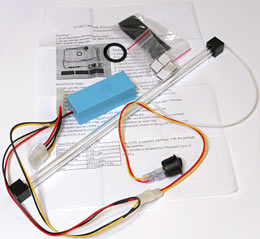
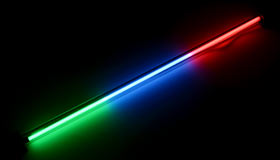
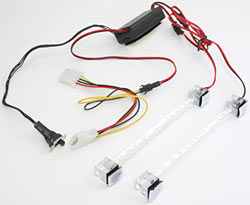
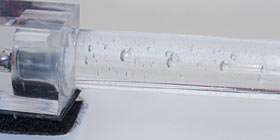
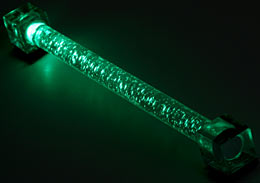
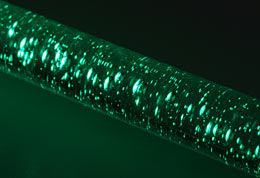
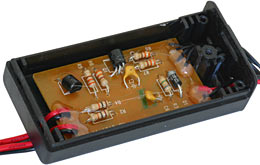
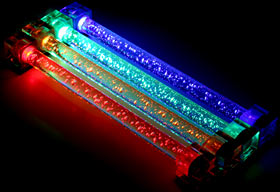
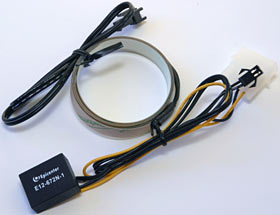
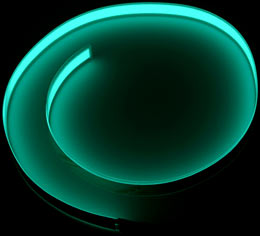
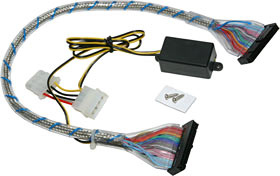
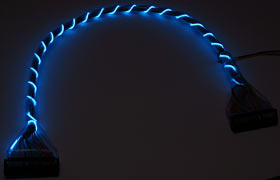
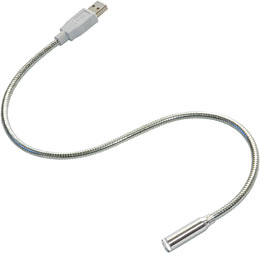
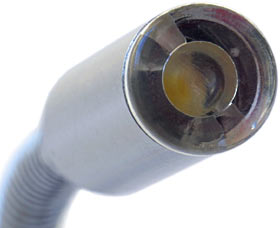
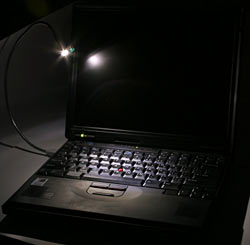
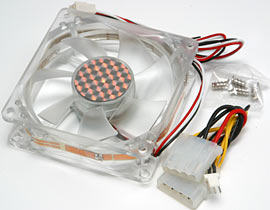
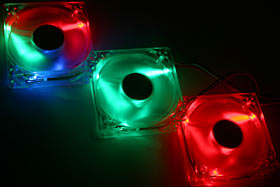
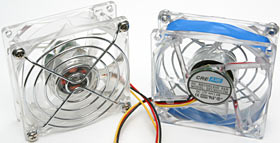
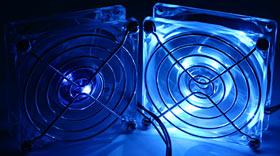
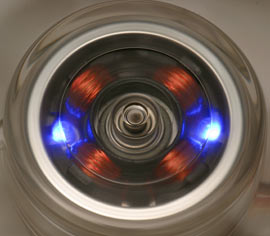
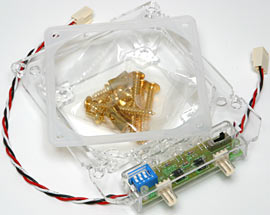
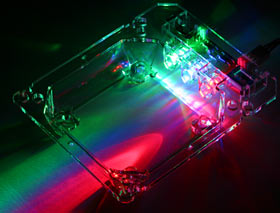
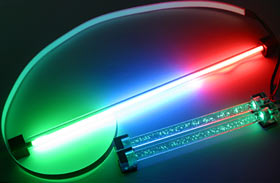
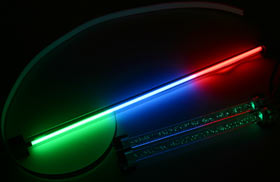

![[SecureWebs]](images/sw.gif)